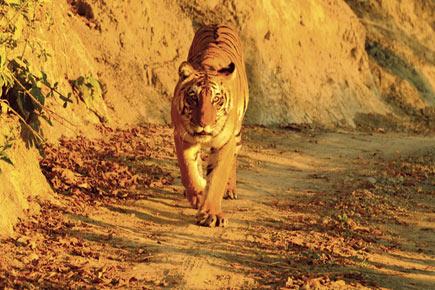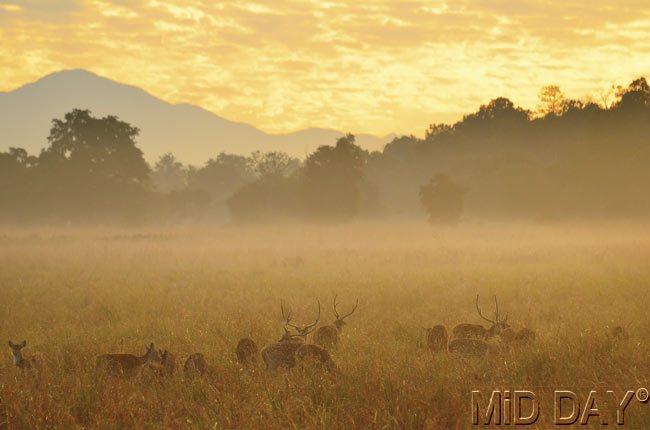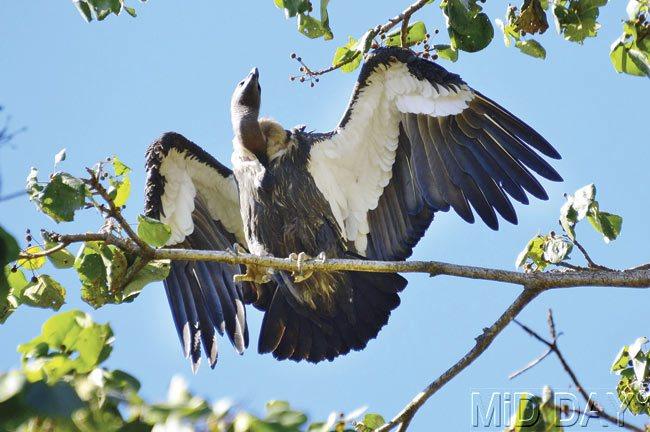At Jim Corbett National Park, you have Great Hornbills and camera-friendly tigers to make your stay worthwhile

Jim Corbett National Park
Best time to visit: Till mid-June
You need: 3-5 days
ADVERTISEMENT
We drum our fingers on the door of the jeep which will take us to the depths of Jim Corbett National Park. We await Kaleem Khan, our guide for the next four days. Khan walks towards us, dressed in a khaki uniform and a pullover.

Sighting a tigress at Corbett is lucky. Having one follow your jeep for a full 15 minutes, serendipity. Pics/Kareena Gianani
He briefly blows into his cupped hands the only indication that it is one degree Celsius (we were there in December). We, on the other hand, tremble just because we exist here, right now, but Khan is oblivious to such trivialities.

The sunlit grasslands in the Dhikala zone at Corbett set its landscape apart from its three other zones
“Before we get in, I must tell you about this family who left yesterday,” he tells us. “Corbett National Park is divided into four zones, and we were at Dhikala — it has the most stunning landscape and the highest density of tigers.”
 There’s much time to stand and stare at birds, such as the White-rumped Vulture here, at the park
There’s much time to stand and stare at birds, such as the White-rumped Vulture here, at the park
“So, did they see the tiger?” my friend asks, his glee barely concealed in spite of telling me a minute ago that he was above “such impolite touristy behaviour.” Khan gestures him to wait.

The Malani Forest Lodge was built in 1920
“We stayed at the lodge which is right in the middle of the jungle, and the generators malfunctioned. The man’s adolescent son got out for a walk in the twilight, and spotted a tiger.”

Jim Corbett National Park is home to more than 600 species of magnificent birds, including the Pallas’s Fish Eagle
My friend snorts. He admires Khan — they’ve bonded over many safaris in the past and he believes every word this young, passionate guide utters. So, it isn’t disbelief, I conclude. Just unadulterated envy.

The Great Hornbill
Khan continues. “The boy only remembers freezing on the spot, and the tiger moving towards him. We, on the other hand, remember him shrieking his lungs out.”

A Changeable Hawk Eagle at the park
By now, Khan has broken into an uncontrollable fit of laughter. I think I’ve missed something. “The next morning, the father refused to get into the jeep. He came up to me and spluttered angrily.
‘Kaleem bhai,’ he said, ‘yeh ho kya raha hai yahaan? Jim Corbett India ka sabse bada national park hai, aur yahaan aapne sher aur haathi khule chhod rakhe hain!
Ek bhi pinjra nahin dikha mujhe (Kaleem, what is happening around here? Jim Corbett is the largest national park, and here, you just allow tigers and elephants to walk around in the wild!
I haven’t seen a single cage here).” “So, did he complain?” my friend asks, gobsmacked. “Yes. And being an architect, he also scribbled a rough floor plan on how the animals can be contained to make Corbett safe for tourists!”
Into the wild
When you’re at Corbett, matters like personal safety are the last thing on your mind. Your immediate concerns include how to get your camera to obey the frozen stumps you insist on calling fingers. How to be warmer. Then, there are existential questions, too (should you just gaze at the placid, graceful deer frolicking nearby, or go shutter-crazy?).
There’s mortal peril to consider (if, it turns out that your guide has a death wish given that Khan looks at the top of trees and the skies, not at the road, when he drives — will you survive?). To add to that, you’ve just discovered that the tip of your nose just does not thaw.
Yet, the coldest thought I have is banished when I step out into Dhikala’s grasslands the next morning. It is just after sunrise, and I may as well have woken up in Africa. The sky swirls with tangerines and pinks, and the savannah-like grasslands stretch beyond our vision, or imagination. Mist hangs all around, and drapes the sentinels of mountains.
Clouds float wistfully, and the colours above change every minute. In the morning, the grasslands seem to have come right out of an Impressionist’s brush. As if to complete the African vision, there’s even a lone acacia-lookalike in the distance.
All those who wander
It turns out it is a blessing that Khan never looks at the road ahead of him. For starters, he does not need to, because he grew up in Corbett and the small town outside of it, Ramgarh.
Secondly, because his neck is craned skyward, we spot a great number of vultures, hawks, barbets, warblers, kingfisher and moorhens. Khan just has to point at a spot in space and I could bet a bird just, well, appears.
Khan spots monitor lizards perfectly camouflaged on faraway barks of trees and brakes spectacularly every time he sees one. He can spot birds silhouetted at twilight, whereas we see mere outlines. While I squint, stare and swear when I don’t see that bird Khan claims is “staring right back at me” he hands me a book.
It is Khan’s much-loved copy of Birds Of the Indian Subcontinent, and he dog-ears the page which has the bird I am supposed to be seeing. Out of pity, once, he drives me to a clearing and scans the skies.
In no time, four magnificent Great Hornbills zoom over our heads, within a minute of each other. It comes to me then Khan must be a bird-conjurer. He doesn’t dispute it when I blurt out the secret.
That night, our home is the Malani Forest Lodge in the Bijrani zone. Stepping into it is like opening a Chinese box you first know that it has no electricity, then the cook admits it would be better if Khan cooks for us, and then, there are those dim lanterns we carry around which throw grotesque shadows on the walls (ours). It is all very ‘Corbettesque’ I am convinced that the night will end with us having solved a mystery of a perilous man-eater.
Malani was built by the British in 1920, and the cook is full of stories of tiger attacks that maimed villagers indiscriminately. He points to the electrocuted barbed wire around the bungalow. “It is possible that a tiger is prowling right there,” he hisses, pointing to a spot outside the window closest to me.
“But you mustn’t worry.” He is right. The night passes uneventfully, after a dinner of a succulent chicken dish which is Khan’s specialty, as is its vegetarian cousin, which he serves over stories of near-death encounters with tigers.
Owls and a tigress
Being in Bijrani gives us access to a patch in Corbett known for its Brown Fish Owl population. Khan earnestly promises that, as a birthday gift, I would get to gaze at an owl, if not a tiger, for several, long minutes. By now, I know better than to disbelieve him. In minutes, my birthday party includes a particularly dour-looking (yet beautiful) owl.
The next morning, we pack our bags and leave Malani. We have not seen a tiger but I don’t mind it one bit. Corbett, as Khan has shown us, is about vastness, mirages on misty mornings and the thrill of the could-be.
With this thought, I put my camera back in my bag.
Khan abruptly brakes and my breakfast almost greets the morning air. He points to the road ahead. A tigress languidly crosses the road, and we silently rejoice our five-second encounter. After she disappears into the forest on our left, Khan drives ahead and waits.
Few things, I know now, will match up to the next 15 minutes. The tigress, it turns out, is graciously waiting for us to cross the road. When we do, she follows our jeep as if she does this everyday.
By now, the cameras are out, and we are torn between staying five feet ahead of her or, as sense and Khan hiss into my ears, 15 feet. Turns out she is quite the poser stretching in the sunlight, staring into space, even pointing her tail to the skies as she follows our jeep. Finally, she disappears before we reach a ravine.
Later, we drive past other jeeps and Khan directs them to her. Somehow, having spotted a tiger makes you strangely magnanimous we find ourselves promising fellow travellers her beautiful, sun-lit photographs.
A few hours later, Khan senses something at the corner of the road and pricks up his ears like he did before. We are satiated, but could it really be? This time, our hearts are somewhere in our throat, but she does not return.
 Subscribe today by clicking the link and stay updated with the latest news!" Click here!
Subscribe today by clicking the link and stay updated with the latest news!" Click here!






